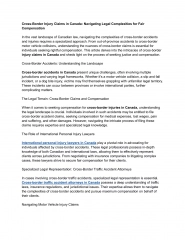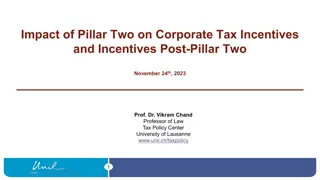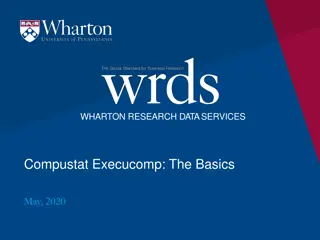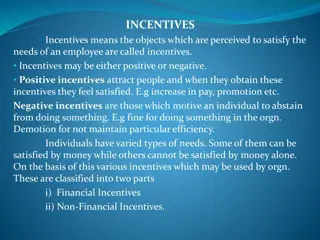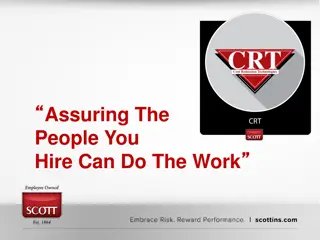Understanding Compensation and Incentives in the Workplace
Compensation and incentives play a vital role in attracting and retaining talented employees. Compensation refers to what employees receive in return for their work, including wages, salaries, and incentives. Incentives are extra rewards that encourage employees to perform better. They are important as they improve motivation, productivity, discipline, and industrial relations. Effective incentives plans should be fair, easy to understand, flexible, and regularly reviewed. Basic forms of incentives include bonuses, merit pay, and commissions for salespeople.
Download Presentation

Please find below an Image/Link to download the presentation.
The content on the website is provided AS IS for your information and personal use only. It may not be sold, licensed, or shared on other websites without obtaining consent from the author. Download presentation by click this link. If you encounter any issues during the download, it is possible that the publisher has removed the file from their server.
E N D
Presentation Transcript
IINCENTIVE PAYMENT UNIT- 6
What is compensation & incentives? Why Incentives are Important? What makes an Incentives plan effective? Basic forms of incentives. Classification of Incentives Plans
What is compensation & incentives? The term COMPENSATION mean togive something in return. Weather in terms of money or product (i.e. goods &services). From the organization point of view, to give something (generally in terms of money) for the work we obtain from the employees. Which includes wages, salaries &incentives. To attract & retain effective & efficient manpower sound company policy has to be designed. The term INCENTIVES mean, something which encourages do something. Or the extra financial reward/motivation . Incentivesis the productivity of the employees. performance-link to improve motivation & Incentives includes all that provide extra pay for the extra p e r f o r m a n c e in addition to regular wages for thejob.
Why Incentives are Important? Incentives are considered beneficial to both employers as well as employees in following ways. monitory rewards for goodperformance. Workers are likely to work at their best when they are offered Provide opportunity for hard-working & ambitious employees to e a r n more. To improve work-flow, work methods & man machine relation ship. To bring employee involvement to make employee innovative. Incentives are the sound technique of improving productivity. Help to improve discipline and industrial relation. The cost of supervision are reduced. To obtain desired result.
What makes an Incentives plan effective? absence an incentives may be viewed as an attempt to improve production/ profitonly. Incentive plan should be installed in consultation with workers & union. Payment of incentives should be free from bias & established t h r o u g h scientific/ proper workstudy. To implement incentives minimum wages shouldbe guaranteed to every workers. It should be easy to understand & simple to operate so that employee can calculate their own earnings. It should provide equal opportunity to all workers to earn incentives pay . Plan should not be very costly in operation. Plan should be flexible to adopt any changes later on. Payment of incentives should be prompt i.e. as early as possible. It should be adequate to motivate each employees. Every plan should be reviewed periodically. In the of mutual trust between employer & workers, plane effectively
Basic forms of incentives. The basic from of incentives are asfollow. Bonuses :- is an incentive payment that is given to an employee beyond his normal standard wages. It is generally given at the end of the year & does not become part of the basicpay. The payment of bonus Act 1965 is applicable to every factory or establishment in which 20 or more person are employed in an accounting year. Merit pay :- is a reward based pay on haw well an employee done the assigned job. Higher the performance Greater will be thereward. The payment is depend on individual employee sperformance. Commission for sales people :- is paid on the basis of sales made by the employee, through different plan. Suchas Salary plan :- where new salesman is appointed, is unable to generatenew. Commission plan :- where organization is totally based on sales of their product. Combination of both :- is the most frequently usedmethod.
Classification of Incentives Plans Incentivesplans Organization- wide Individual Group Profit sharing Time-based Co-partnership Time-based Gain-sharing Output-based ESOPs
Individual Time based incentive plan Under time based plan, per hour wage rate is determined & incentives paid on the bases of timesaved. Time based incentives plane is divided in four differentways. Hasley plan, Rowan plan, Emerson plan, Bedeuaxplan. This all plan more or less follow same method i.e. (pay bonus on the basis of timed saved by employee), but with differentformula. Output based incentive plan Under output based plan, per piece wage rate is determined & incentives paid on the bases of output produced. i.e. more output in standard time OR standard output in lesstime. For output based incentive following 3 method can beused. Taylor plan, Merrick plan, Gnatt plan.
Organization- wide 1 Profit sharing Profit sharing is an arrangement by which employees receive in addition to wages, a share is fixed in advance in profit of the enterprise. It is an agreement between employer & his employee. According to International Labour Organization, Profit-sharing is a method of industrial remuneration under which an employer undertakes to pay to employee, a share in net profit of the enterprise in addition to regularwages Co-partnership Co-partnership is an extension ofprofit-sharing. Under this method worker s share in company s profit is paid in the form of share by which they become entitled to participate in decision-making process.
Organization- wide 2 Gain-sharing This method aims at increasing productivity & decreasing labour cost & sharing the result gains witemployee. It is based on a mathematical formula which compares a standard perform with actual performance during givenperiod. When actual performance exceed the standard performance, shaving are shared with employees. ESOPs (Employee Stock Option Plans) This method is originated in the USA in early90s. Under this plan, the eligible employee are allotted company s share below the market price. The term stoke option implies the right of eligible employee to purchase a certain amount of stoke in future at an agreedprice. The eligibility criteria may include length of service, contribution to the departmentetc
Group Group based or team-based incentives plans reward all team m em bers equally based on overall performance of the teammember. Under group based out put can t be measured. So team performance is evaluated on the basis of time taken r a t h e r than output produced, if team complete their target in well advanced to standard time the team member are eligible for incentives. Payment to team members may be made in the form of cash bonus or in the form of non-cash reward such as pleasure trip, times off or luxury items. Team based incentives foster cohesiveness among tem members. Methods for team based incentives plans are Preistman s productionplan Rucker plan Scalon plan on incentive plan, individual
PRE-REQUISITES OF EFFECTIVE INCENTIVE SYSTEM All things considered, it may be concluded that in many industries or undertakings and for a large group of operations, well-designed systems of payment by results shall yield advantages to all concerned. Many of these advantages will be realized provided sufficient safeguards are provided. Such p re-requisites are: 1. The co-operation of workers in the implementation of an incentive scheme is essential because the employees somehow devise, if they do not like a scheme, ingenious ways of evading or sabotaging the plan, often with the tacit connivance of the foreman or supervisor,'' Workers' co-operation may be secured through proper discussion with their representatives. In particular, workers' co-operation is necessary in: (i) The methods followed in measuring the results or output upon which payment is based; (ii) The methods followed in setting wage rates for different classes of work; and (iii) Appropriate safeguards concerning earnings, job security and settlement of disputes over piece-work rates and allotted time.
PRE-REQUISITES OF EFFECTIVE INCENTIVE SYSTEM 2. The scheme must be based on scientific work measurement. The standards set must be realistic and must motivate workers to put in better performance. Workers must be provided with necessary tools, equipment and materials so as to enable them reach their standards. 3. Indirect workers, such as supervisors, foremen, charge hands, helpers, crane operators, canteen staff, store keepers, and clerical staff should also be covered by incentive schemes. 4. There should be management commitment to the cost and time necessary to administer incentive schemes properly, and these must be carefully assessed before embarking on an incentive programmed. There are many situations in which the potential gains are just not worth the cost and effort involved. 5. There is greater need for planning. Many incentive schemes, started hurriedly, planned carelessly, and implemented indifferently have failed and have created more problems for the organization than they have tried to solve.
PRE-REQUISITES OF EFFECTIVE INCENTIVE SYSTEM 6. The other safeguards are: (i) The incentive scheme should be appropriate to the type of work carried out and the workers employed. (ii) The reward should be clearly and closely linked 10 the efforts of the individual or group. (iii) Individuals or groups should be able to calculate the reward they get at each of the levels of output they are capable of achieving. (iv) Individuals or groups should have a reasonable amount of control over their efforts and therefore their rewards.
PRE-REQUISITES OF EFFECTIVE INCENTIVE SYSTEM v) The scheme should operate by means of a well-defined and easily- understood formula. (vi) The scheme should be properly installed and maintained, (vii) Provisions should be made for controlling the amounts paid, to en- sure that they are proportionate to effort. (viii) Provisions should be made for amending rates in defined circumstances (ix) Create incentives for performance and disincentives for non-performance. (x) Set and review specific objectives for each employee periodically.
SCOPE OF INCENTIVES SCHEMES The incentive payments have a universal appeal and their application is confined to certain important industries. Stated differently, payment by results schemes are difficult to apply in: 1. Industries in which measurement of individual or group output is rendered difficult or impossible either by technical consideration or by psychological circumstances which might be prejudicial to output. 2. Industries in which the control of quality is necessary and is particularly difficult, or in the case of certain classes of workers, where high quality and precision of work is of prime importance; and
SCOPE OF INCENTIVES SCHEMES 3. Industries in which the work is especially dangerous and is particularly to ensure the observance of adequate safety precautions. Barring the above three categories, incentive schemes can be applied to all industries. Specifically, they are being successfully employed in the textile and metallurgical industries, the metal trades, mining and many branches of clothing, leather and rubber industries. Incentive schemes have also been successfully applied in certain countries and in certain circumstances in the building industry and in chemical and other industries.
TYPES OF INCENTIVES SCHEMES Incentives schemes are many and varied. The International Labor Organization (ILO) classifies all the schemes of payment by results into four categories. They are:- 1. Incentives schemes where the workers earnings vary in the same proportion as output. 2. Schemes where earnings vary proportionately less than output. 3. Schemes where earnings vary proportionately more than output. 4. Schemes where earnings differ at different levels of output.
TYPES OF INCENTIVES SCHEMES As a rule, incentives must not be introduced in a newly set-up unit. Workers must be content with time-rated earnings, at least, during the first four to five years. The time period is necessary for the unit to carve a niche for itself in the market. This being achieved, it would be easy for the unit to sell increased output brought in by incentives. Furthermore, as was noted earlier, incentives are likely to affect the quality of output. Any defect in quality would seriously affect fortunes of the newly set up unit, particularly in its formative years.


